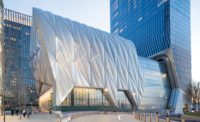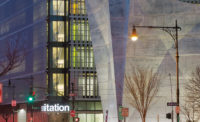SHED
The Modern Grange: A San Francisco firm turns a workaday agricultural building into a gleaming display case for locavore living.


















Architects & Firms
Healdsburg, California
Northern California &mash; the region that gave birth to Chez Panisse and the French Laundry — is ground zero for the local-food movement, and SHED, an haute general store in the heart of wine country, lets you know it even before you walk through the door. Located in Healdsburg, a tiny city at the convergence of three vineyard-striped valleys in Sonoma County, SHED stands just a few blocks from the wine destination's immoderately quaint town square. Its neighbors include preppy boutiques catering to affluent oenophiles and structures styled as faux chateaus. But SHED is literally a shed'an agricultural building made from pre-engineered components'with a classic, gable-sided form that signals the market's roots on the farm.
Behind its glass facade, the 10,000-square foot, two-story retail space offers a tightly curated selection of sustainably sourced goods and locavore lifestyle accoutrements. You can shop for fresh produce, artisanal dry goods, well-crafted cookware, and heritage-brand garden tools. You can also have a meal prepared with many of the same utensils and ingredients, sip a latte poured with a perfect leaf pattern, or drink a beer or a kombucha at the 'fermentation bar.' An upstairs space operates like a modern country grange, hosting everything from beekeeping workshops to jazz concerts. 'It's not just a food place, but more of a hub,' says SHED co-owner Cindy Daniel. 'As much as possible, we want to show the hand, the people, the process behind the food.'
Daniel and her partner, Doug Lipton, own a small farm a few miles outside of Healdsburg in the Dry Creek Valley. For years they had considered opening a store in town; they eventually found a site across from a parking lot that hosts a twice-weekly farmers' market. They met Jensen through a mutual friend, and after playing with the idea of reusing an existing appliance store on the site, the architect persuaded them to replace it with the agricultural shed. Not only did the pre-engineered building'commonly known as a Butler building, though the project uses a different brand'save on construction costs and waste, it also saved time. A creek runs along one side of the lot, and the project required drilling 40-foot helical piles into the soft soil before the building's concrete slab was poured. Once that was in place, the structure went up in a matter of weeks.
To turn the barn into a showcase, the firm used glazing for its entire front elevation, with transparent garage doors opening to the sidewalk and to a pair of terraces facing the recently restored creek. The building is otherwise clad in off-the-shelf insulated metal panels. Transom windows'which operate automatically to flush out hot air from the interior at night'run the length of the building, accentuating the ceiling height and bringing in a huge amount of daylight. Jensen's team kept the building's perfect, Monopoly-piece profile by tucking rain gutters into the roof and hiding HVAC equipment in a well toward the rear of the building. They punctuated the street-side facade with a second-floor deck that cantilevers 10 feet over an outdoor seating area. 'This is technically vernacular in terms of what agricultural buildings look like today,' says Jensen. 'We wanted to avoid a nostalgic wood-sided barn, the Disneyland approach.'
Inside, a coffee bar brings a social space to the entry, while different areas of the program pivot around a central kitchen and caf' counter anchored by a wood-fired oven. The structure's large spans and the well-scaled partitions allow the components to flow into one another with an openness that mimics the owners' approach to food. Items on the shelves end up on the menu at the caf', cross-pollinating according to seasonal themes. 'If we have cazuela bowls in the housewares section, we're also using them in the kitchen,' says Daniel. 'We want to really arouse people's curiosity'to encourage them to taste an ingredient or even learn how to grow it.'
On the loftlike second floor, the project's main kitchen is separated from the event space by a sliding, wood-covered wall. It can open to display the cooking process; a screen rolls down to protect food preparation when the doors leading to two terraces are open. Or it can close completely to insulate performances from kitchen noise. Even without an event taking place, the project is a social space for Healdsburg's culinary-minded locals as well as weekenders and wine tourists. 'It's kind of like the new post office,' says Jensen. 'It's the place where people come to meet and greet and hang out.'
The design strikes a note between rustic and rarefied, but it rings more toward the latter. A palette of light wood and bright-white walls elevates the workaday building into a gallery that fetishizes the growing, making, and serving of food. And on Healdsburg's streetscape, it projects through its glass facade the ideas about culinary culture that made the region famous.
PeopleOwner: Cindy Daniel and Doug Lipton Location: 25 North Street, Healdsburg, Ca. 95448
Architect:
Personnel in architect's firm who should receive special credit:
Engineer(s):
Consultant(s): Surveyor: Curtis & Associates Landscape: Russian Riverkeeper (Rain garden) A/V and Controls: Lavish Automation Acoustical: Terry Hill
General contractor:
Photographer(s): CAD system, project management, or other software used: Vectorworks, Sketch-up, V-Ray. Size: 10,800 square feet Cost: withheld Completion date: April 2013 |
Products
Structural system Manufacturer of structural components unique to this project: Soule Building Systems/ CBC Steel Buildings
Exterior cladding Metal/glass curtain wall: Arcadia (storefront doors, windows, curtain wall) Wood: Evan Shively, Arborica, urban salvage reclaimed wood: Monterey Cypress decking, wall and eave cladding, trellis, guardrail caps. Curtain wall: Arcadia
Roofing Metal: Kingspan (see ‘metal panels’ above)
Windows
Glazing Skylights: Sunoptics
Doors Wood doors: Oregon Door (Agrifiber core interior doors) Sliding doors: Custom, by G.C. Fire-control doors, security grilles (roll-down insect screens): High Tech Screens and Shades Upswinging doors, other: Clopay (overhead garage doors)
Hardware Closers: LCN Exit devices: Von Duprin (panic hardware) Pulls: Rockwood Other special hardware: Hafele (sliding wood wall in Event Space)
Interior finishes Paints and stains: Benjamin Moore, Vermont Natural Coatings, Rubio Monocoat Special surfacing: Retroplate concrete polishing system (exposed concrete floors) Floor and wall tile: Sonoma Tilemakers (Coffee bar and Event Space bar faces, Larder and Fermentation Bar backsplashes, restroom and kitchen wall tile). Daltile (Kitchen floor) Special interior finishes unique to this project: Evan Shively, Arborica, urban salvage reclaimed wood: Event space elm wood flooring, elm wall cladding, Monterey Pine slat wood ceiling, Farm area Monterey Cypress wall cladding, Coffee Bar elm wood tops and Larder Bay Laurel butcher block countertops
Furnishings Tables: Scott Constable, Foster Fine Woodworking
Lighting Downlights: Portfolio Task lighting: Halo, Sylvania Exterior: RSA, Hi Lite Manufacturing Dimming System or other lighting controls: Crestron
Conveyance
Plumbing
Energy Photovoltaic system: Real Goods Solar
Other unique products that contribute to sustainability: Acoustic insulation: Bonded Logic (Recycled denim batts in event space ceiling and interior wall cavities)
Add any additional building components or special equipment that made a significant contribution to this project: |














